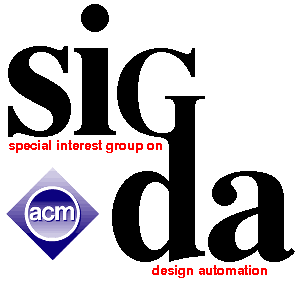
 |
SIGDA's CADathlon at ICCAD
Sunday, Nov. 7, 2010
|

HomeProblems
Contest
|
Problems and ReferencesTo download the tar.gz file for all related papers, click here.Problem 1: Circuit Design & AnalysisContributed by: Ning Mi, Cadence Design SystemsOverview: Process variability in power-grid networksStochastic Power Grid Analysis Considering Process Variations, Problem 2: Physical DesignContributed by: Love Singhal, SynopsysOverview: Tangled logic detectionDetecting Tangled Logic Structures in VLSI Netlists, Problem 3: Logic & High-Level SynthesisContributed by: Smita Krishnaswamy, Columbia UniversityOverview: SAT-based design error diagnosisDesign Diagnosis Using Boolean Satisfiability, Problem 4: System Design and AnalysisContributed by: Srinivasan Murali, iNoCsOverview: ILP-based on-chip communication architecture core allocation for chip multiprocessorsAn Application-specific Design Methodology for STbus Crossbar Generation, Problem 5: Functional VerificationContributed by: Hao Zheng, University of South FloridaOverview: Cycle-based logic simulationCycle Simulation Techniques, The AIGER And-Inverter Graph (AIG) Format , Version 20070427, Problem 6: Bio EDAContributed by: Tsung-Yi Ho, National Cheng Kung UniversityBroadcast electrode-addressing for pin-constrained multi-functional digital microfluidic biochips, Optimization by Simulated Annealing, Computer PlatformDuring the contest one desktop computer will be available per team, running a standard installation of Ubuntu Linux. All necessary software and the problem statements will be pre-installed. In your home directory you will find a beginning directory structure to organize your work and initial problem frameworks such as parsers.You will be allowed to bring in any written or printed materials, but no electronic storage media or computing devices. (If you have a preferred VIM or Emacs configuration, you will need to print them out beforehand and type them in.) Whatever you bring in shall stay in the room until you decide to leave the room at the end of the day. You will not have any internet or phone access during the competition, and you are expected not to discuss any questions with colleagues other than your team member.
|
|
| Problem subjects and reference papers are available now! |